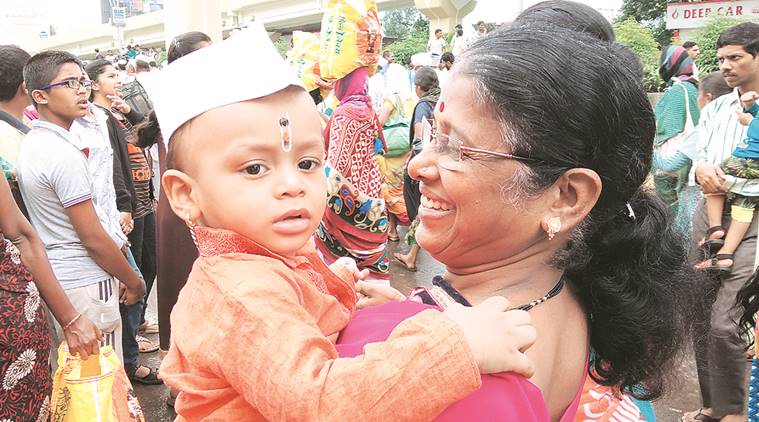 A young warkari.
A young warkari.
Lakhs of devotees or warkaris, from farmers’ families in rural Maharashtra, participate in the Ashadhi palanquin procession from Dehu and Alandi to Pandharpur every year, making it one of the biggest pilgrimages in the world. As the palanquins of the great saints of Warkari sect rest in the city, Atikh Rashid traces the history of the tradition.
The history
The Pandharpur pilgrimage precedes the lives of Sant Dyaneshwar and Sant Tukaram, the most revered saints in the warkari tradition. One finds mention of the annual pilgrimage in the writings of 13th-century saint, Sant Dyaneshwar, who, in one of his popular ovis, thanks his father for taking him to the pandhri yatra, where he got a darshan of Lord Vithoba. It is believed that the Pandharpur pilgrimage tradition has been followed for at least 800 years.
Sant Bhanudas and Sant Eknath continued this tradition through the 15th and 16th centuries, say historians. Later, saints from the Bhakti tradition are believed to have continued the wari tradition, but in different forms. Sant Tukaram, a 17th century saint who is among the most prominent saints of the Bhakti tradition in the state, used to go on an annual pilgrimage by wearing Dyaneshwar’s padukas (footwear) around his neck.
The wari took its present form — now, padukas are carried in beautiful palanquins, while devotees follow them — in the 19th century. The fable is linked to how Haibatbaba Arphalkar, a Sardar in the Scindia dynasty of Gwalior, became a devotee of Dyaneshwar.
Some time in the late 1820s, Sardar Haibatbaba was travelling towards Satara, when he was assaulted and kidnapped by dacoits. While in their captivity, he prayed to Sant Dyaneshwar to save him. It is said that because of his prayers, the wife of the dacoit’s leader gave birth to a male child. The elated leader ordered that Haibatbaba be released. Haibatbaba gave all the credit for his rescue to Dyaneshwar and decided to spend the rest of his life in service of the saint.
Haibatbaba is said to have re-introduced the tradition of a separate wari for Dyaneshwar Maharaj, which had, by then, merged with the wari of Sant Tukaram. With the help of wealthy patrons, Haibatbaba managed to turn the procession into a grand event, with palanquins, elephants, horses, musical instruments and thousands of devotees, who were part of groups called dindis. The tradition continues till today.
The journey
The wari starts from Dehu and Alandi on the 8th or 9th day of the Hindu month of Jyestha. It reaches Pandharpur on the 11th day of Aashaad, when the procession of devotees culminates at the feet of Lord Vitthala. Vitthala, also known as Vithu-Mauli or mother Vitthal, is considered to be an incarnation of Vishnu.
As per the tradition of the Bhakti movement, four annual processions to Pandharpur take place every year, in the months of Chaitra (March-April), Ashadh (June-July), Kartik (October-November) and Magh (January-February) of the Hindu calender.
Of the four, Ashadhi wari is the most popular among devotees, and lakhs of them participate in the processions. Since the warkari sect mostly comprises farmers, they find the timing of the Ashadhi wari convenient. By the time the processions start, the farmers have already completed sowing their crops, and have little agricultural work for the next few weeks.
Sant Tukaram’s palkhi procession starts from Dehu and reaches Pandharpur via Akurdi, Pune, Loni Kalbhor, Yavat, Baramati, Indapur, Akluj and Wakhri. Sant Dnyaneshwar’s palkhi follows a different route — it enters Pune from Alandi, then heads towards Pandharpur through Saswad, Jejuri, Lonand, Phaltan, Malshiras, Shegaon and Wakhri.
Inside the processions
While the two processions reportedly attract over six lakh devotees from across the state, it is relatively easy to organise and manage them as the devotees are divided into groups called dindis. Each dindi or unit comprises anything between 50 to 1,000 warkaris.
Each dindi has a leader as well as other members, who are assigned specific responsibilities, including organising night halts and meals for participants. Other groups are responsible for the bhajan, kirtan and ‘entertainment’. Sant Dyaneshwar’s palanquin is accompanied by about 250 dindis, while Sant Tukaram’s palanquin is accompanied by over 330 dindis. Dindis are assigned specific numbers, denoting their position in the procession, and whether they are in front of the palanquin or behind.
These two palanquins are not the only ones taken by devotees to Pandharpur.
As many as 68 palanquins join the procession, carrying padukas of other saints such as Sant Eknath, Nivrutti Nath, Sopan Kaka, Muktabai and Babaji Chaitanya. With time, the nature of the pilgrimage has changed slightly. In the olden days, the dindis used to walk on foot to reach Alandi or Dehu from their respective villages, then start the procession and continue on foot to Pandharpur.
They used to come back home, all the way from Pandharpur to their villages, on foot. Now, the journey has become slightly easier as devotees travel to Dehu and Alandi in trucks and make the rest of the pilgrimage on foot. Travelling by vehicles also makes it easier to carry food and other necessary items for part of the journey, as the devotees earlier had to carry these items themselves.